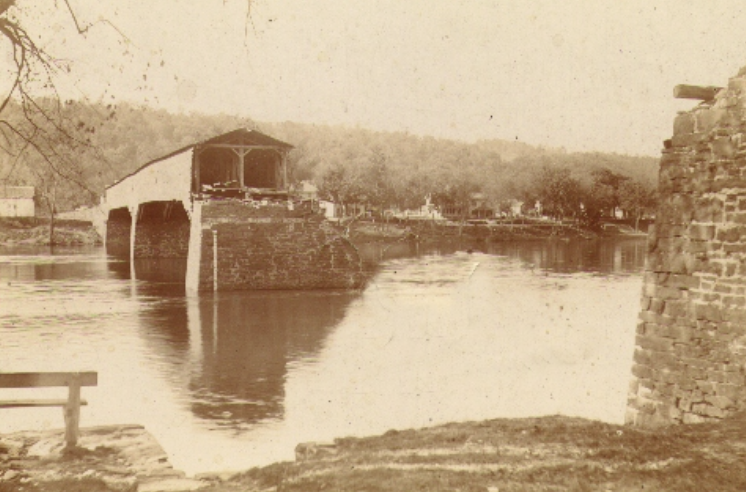Archives of 1903 Easton flood reveal horrific destruction
The Milford-Upper Black Eddy bridge used to be located 15 miles down river of Easton but was destroyed during the 1903 flood. (Photo courtesy of Lafayette College Arts Center Flooding)
March 25, 2022
In October 1903, a large amount of the Northeastern states suffered from a high rainfall event that eventually resulted in a flood. Easton was one of many areas caught up in the severe flooding that would end up causing massive destruction to both physical infrastructure and human life.
Thomas Lannon, director of Special Collections and College Archives at Lafayette College, provided The Lafayette with a document listing the heights of numerous floods throughout Easton’s history. The flood of 1903 was at a wave crest of 38.10 feet, making it second in height to a flood in 1955.
Headlines from the Easton Daily Express, which became the still-existing Express-Times after a merger with Bethlehem’s Globe Times in 1991, provide plenty of information on the 1903 flood and the effect it had on Easton and nearby cities. The 118-year-old news article contains harrowing descriptions of the natural disaster, with the main headline on Oct. 10, 1903 reading, “BODIES OF FLOOD VICTIMS FOUND IN A MELON FIELD.”
The flood first began in New York City. The Easton Daily Express reported the severe damage of high waters before they even crossed state lines into New Jersey.
“Many trolley lines and railroads were either crippled or delayed and in New York City, a conduit containing seventy telegraph wires was so flooded as to disable all the wires,” the article from Oct. 8, 1903 read.
The devastation progressed as the raging waters continued to spread eastwards to New Jersey. Across the Hudson River from New York City, Hoboken and Jersey City were reported by the Easton Daily Express to have flooding so severe that “passengers were carried across it in grocers wagons.” In Paterson, New Jersey, it was reported that “destructive flooding” had caused the waters to rise to a foot and a half in height.
When the floods reached Easton, the ensuing destruction was horrific for Easton’s residents, as reported by the Easton Daily Express on Oct. 10, 1903. The damage to physical infrastructure was very severe, as the article stated that an amount of one million dollars (more than $32 million today after adjusting for inflation) was believed to be a conservative estimate of the damage done by the flood.
“Thousands of people share that loss,” the Easton Daily Express reported. “Capitalists who have their money invested in business enterprises that have been crippled; property-owners who have had buildings damaged; tenants, who in many cases have little left of their household effects; mechanics, who are forced into idleness because the flood has temporarily stopped work at many places.”
While the damage to Easton was severe, it did inspire a large relief effort in the city. It was reported that aid was given to the suffering people in many forms, ranging from clothing to shoes to cash.
“Representatives of the charity organization told of having visited the flooded districts and found want and suffering in many instances,” the Easton Daily Express reported. “But it is thought that relief can be had in comparatively short time.”

























































































































